Tactical Analysis: How Portugal Narrowly Prevailed With a Win vs. Czechia
Since replacing Fernando Santos at the helm, it has been clear that Roberto Martinez wants to define what it means to play offensive and dominant football in an effort to shift the Portuguese national team’s footballing paradigm. Portugal started their championship run on a strong note by crushing Czechia in the final minutes of the game, having won 8 of the 8 qualifying matches with 31 goals scored and 5 goals allowed.
With the game’s tactics in mind, the management decided to start the game in an unconventional 3-4-3, with Diogo Dalot on the right side. This analysis will focus on Portugal’s ideas and tactics during their match versus Czechia, in which they secured the tournament’s first victory.
Portugal appears to be a totally different squad under Martinez; instead of playing to win and sit back for the full 90 minutes, they now play captivating, dominant football and, despite the score, reach the back of the net.
Martinez has made many apparent changes, one of which being his enthusiasm for a national team that is attempting to establish itself as an unavoidable force in international tournaments, as opposed to the previous style of playing it safe and holding the defensive line, encouraging teams to attack and frustrate them all.
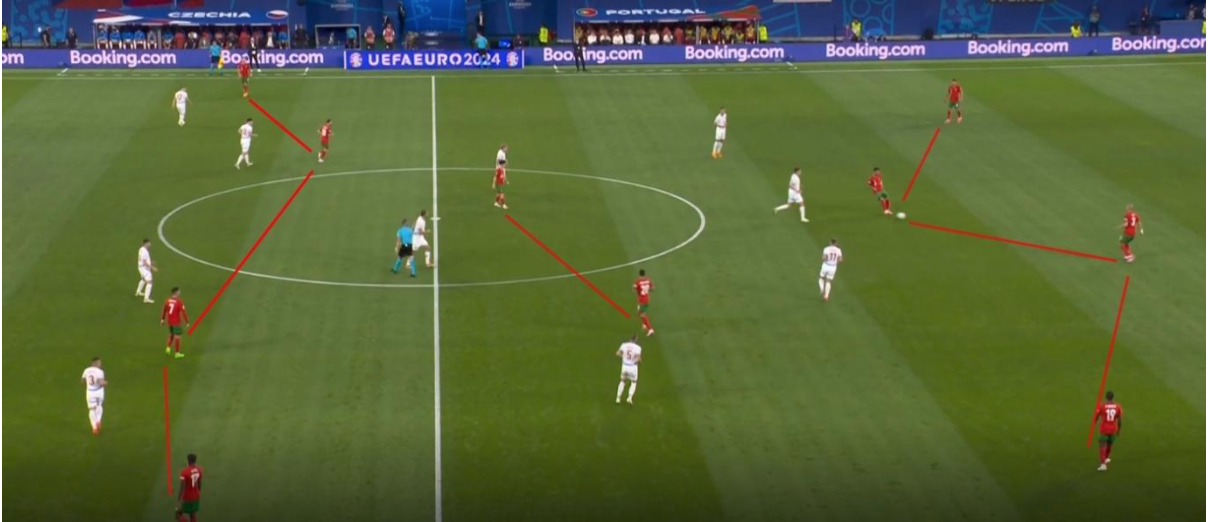
Diogo Dalot was used as an attacking winger with more threat in the attacking third and fewer defensive responsibilities, such as counter-pressing and covering spaces, despite the Portugal team having more players in the midfield at the beginning of the game. In order to establish a 4-2-4 formation during the build-up, Bruno Fernandes assumed the role of false 9, with Vitinha and Joao Cancelo serving as the game’s twin pivots.
Although Martinez allows his players to express themselves freely on the field, he is a manager who likes to play by his rules and stick to a strict game plan. In this particular game, Cancelo and Bruno switched roles from false 9 to pivot in successive periodic times to shift the tactics giving a learning edge for all the players in the game.
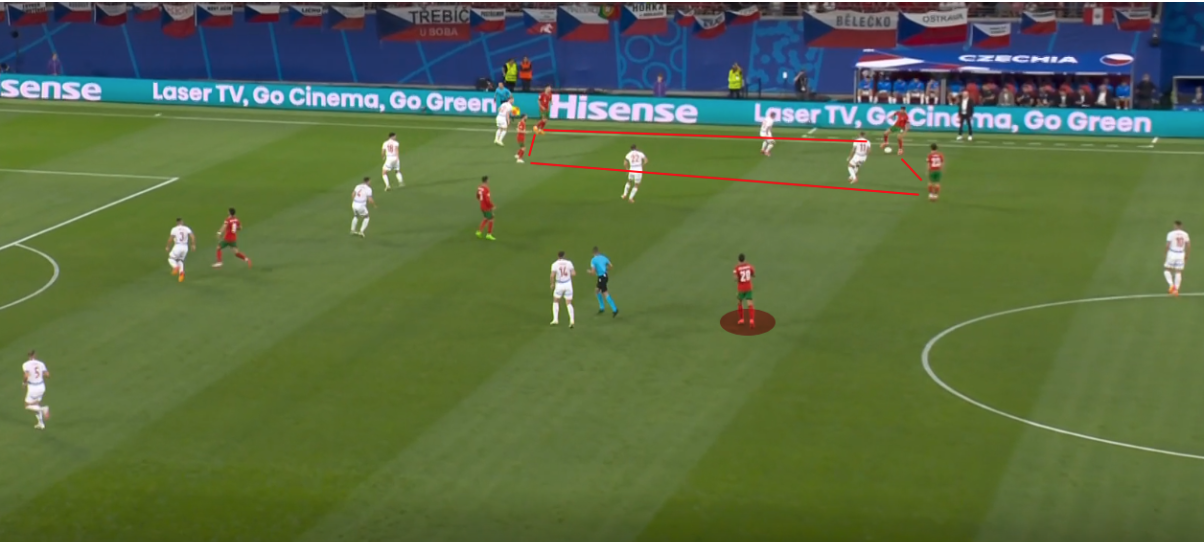
To force play to one side by forming a 4-man box that invites pressure to create gaps near the corner flag and the edge of the 18-yard box to free up two strikers near the grouped players, and in the event that the ball is lost and a counterattack is launched, a man takes up a position based on the line near the grouped quartet with a more defensive role in the build-up. This was the theory behind playing two mid-field players with Vitinha acting as the bridge holding the attacking line and defensive line.
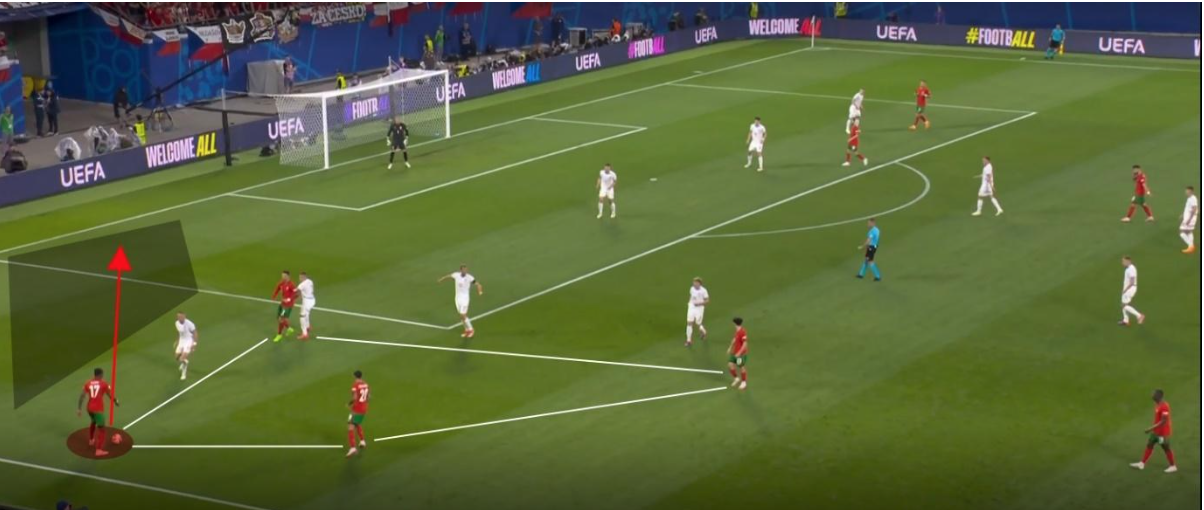
In addition to being effective tactically, this method of constricting the playing field and erecting a box to draw in additional pressure and guys to clear space has also benefited individual players who were attempting to express themselves. Leao gains possession of the ball in this scenario, and as the pass takes out the defender close to the box, breaking the defence, he uses his pace and the appropriate technique to go past two players and deliver a dangerous cross into the penalty area. We can see another player behind the formatted 4 at the same moment, providing defensive support to turn the ball and maintain control.
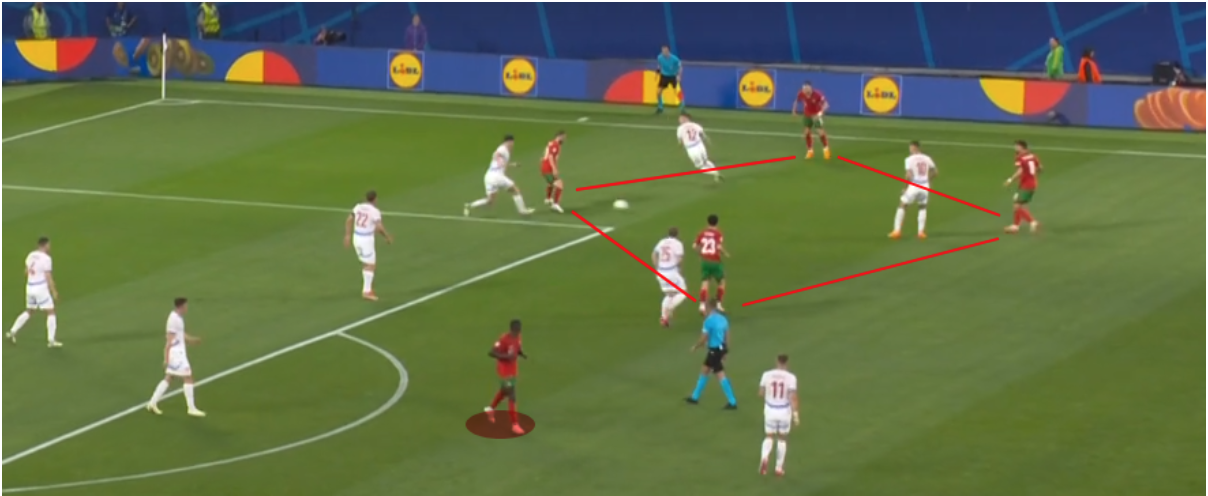
By arranging the same kind of play to generate another opening close to the corner flag, Portugal was able to produce another fantastic opportunity. Dalot is able to get past pressure by holding the ball and drawing pressure from Bernardo Silva. He then passes it to Bruno Fernandes, who is at the bottom of the formatted 4.
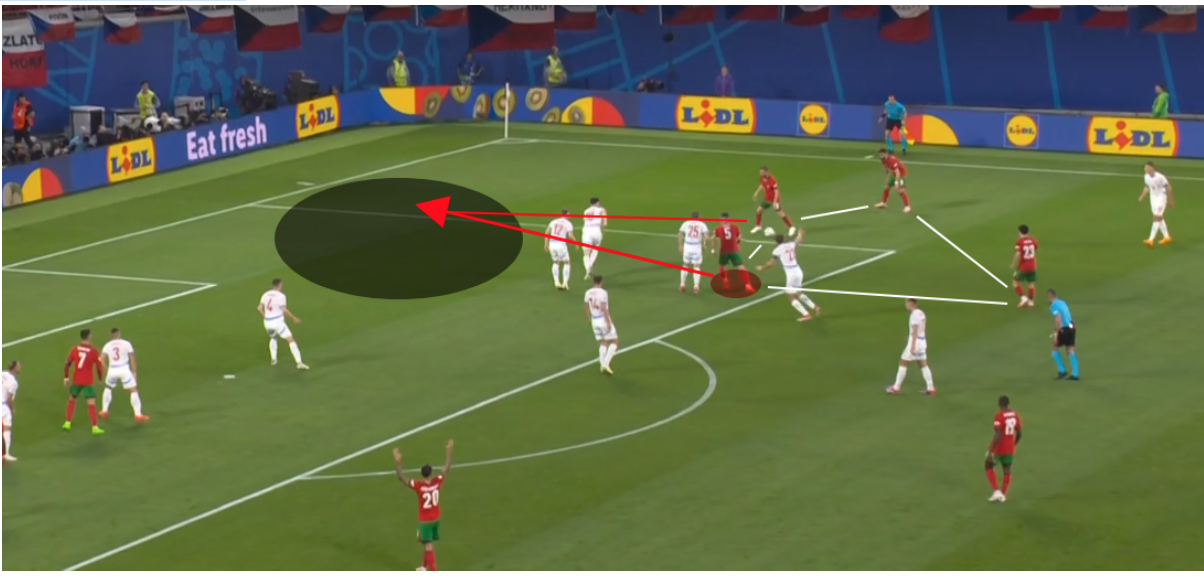
The image above is an extension of the previous move, demonstrating how manoeuvring inside a restricted area and exchanging positions allowed Portugal to breach the Czech defence. After Bruno squeaks by Silva with a weak touch, Dalot passes the ball to him. Dalot then goes on a stunning run, outpacing three players to produce a dangerous cross that could have given Martinez’s team the lead.
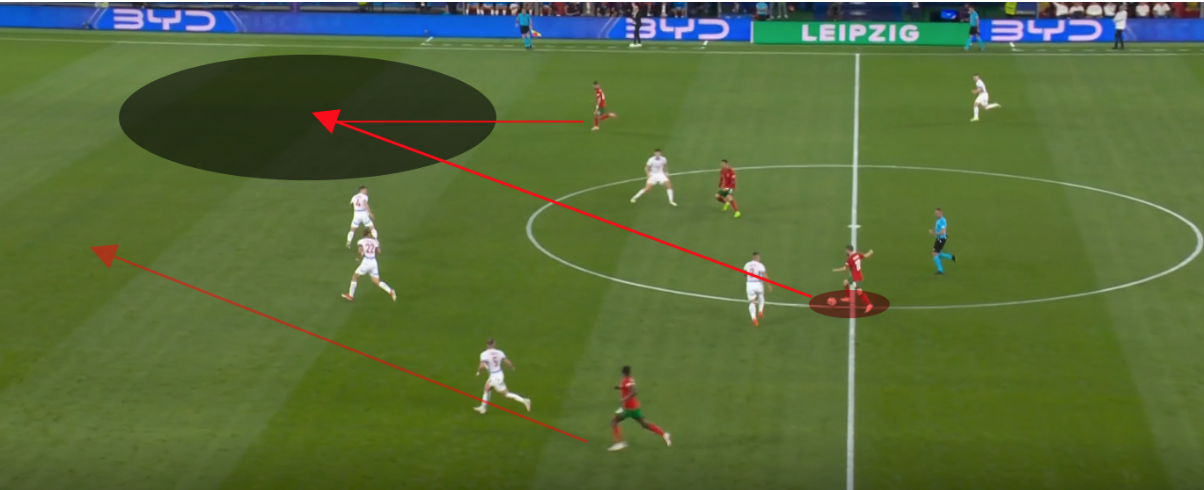
When this Portugal squad is given the pace and time to counterattack, Martinez has once again shown what kind of manager he is. The only question now is how the ball ends up in the goal. Silva sees Fernandes’ run and makes the ideal pass to give Bruno time to advance; he then sees Leao running ahead of the full back and makes a pass that is a little bit overweight, preventing them from taking an early lead. Along with Italy on the list, this Portugal team is among the most dangerous when it comes to countering with pace, talent, and experience.
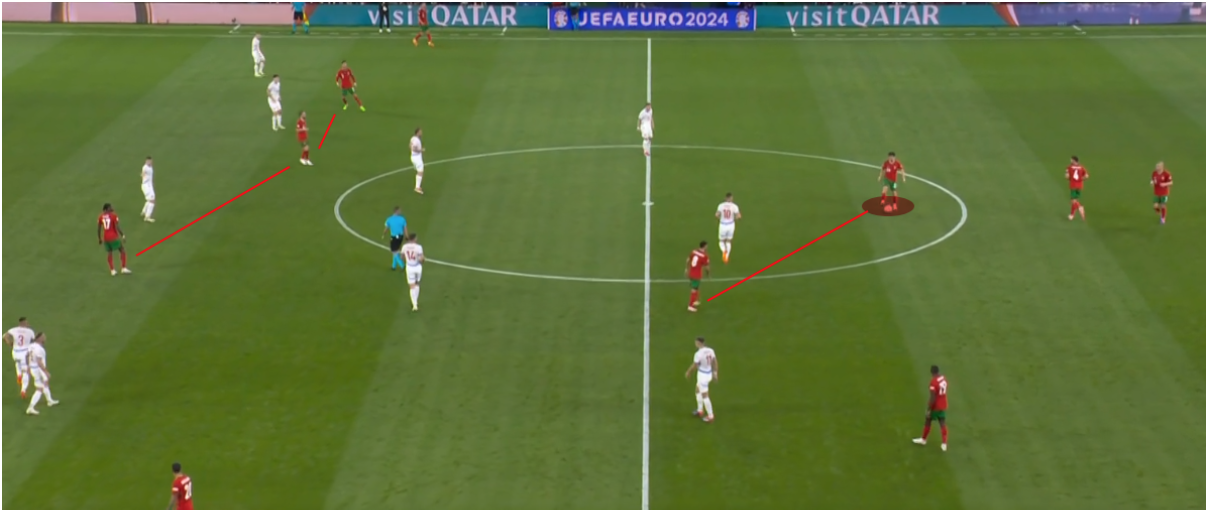
One of the best tactical ideas of the game was the philosophy of playing with just two midfielders and four attackers, with two strikers positioned at the 18-yard line and the other two occupying positions in the touch line to create space for the strikers to score.
However, Czechia deserves credit for their excellent positioning in preventing Portugal from making through balls and line-breaking balls. The third player in the photo is Bernardo Silva, who is filling in as a striker to assist Leao and Ronaldo in bursting through the Czech defence’s lines.
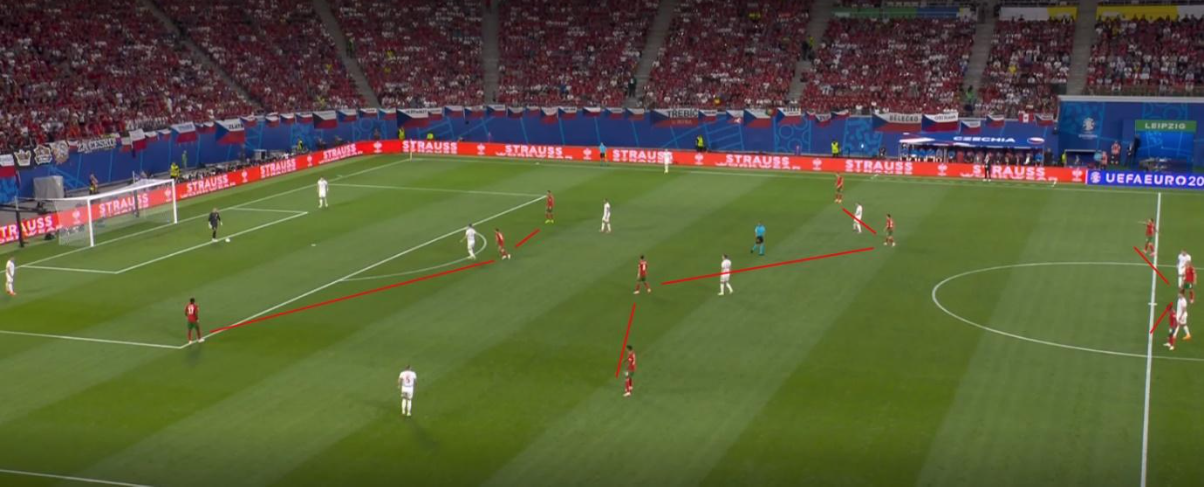
Portugal’s defensive transitions have significantly improved; applying pressure high up the field and man-to-man marking directly after the goal kick has been crucial to Portugal regaining possession. The coaching manual has made it quite evident that they want to push high and aggressively from the box, man-to-man.
The idea of a defensive formation with four midfielders is to outnumber the opposition and dominate the play. To ensure that they may be pressured, attacking players 3 and mid-4 are always accurate in maintaining their line and depth relative to their opponents.
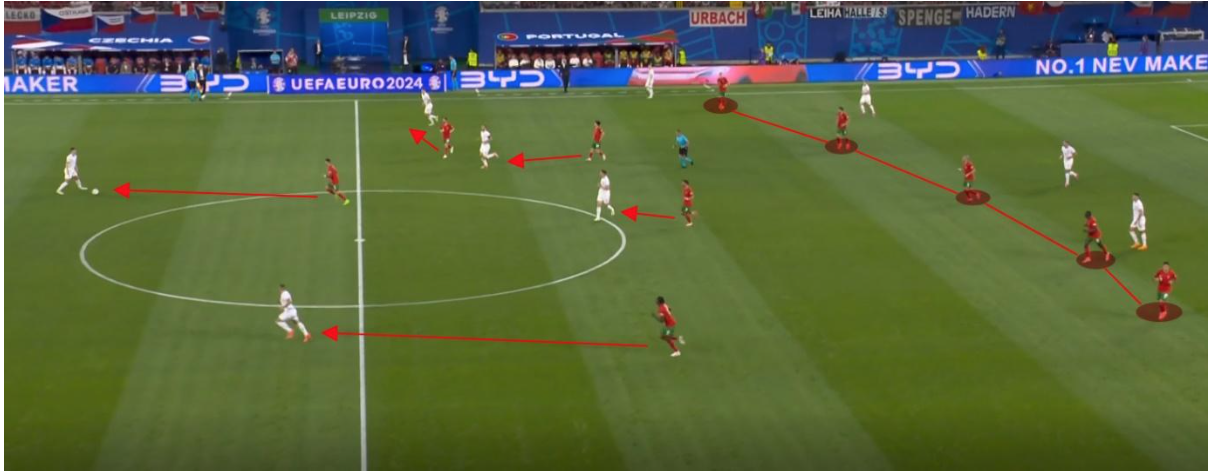
Portugal sets up a defensive line of five with the pivot and Dalot dropping down with the back three to help narrow the gap and prevent line-breaking passes and through balls when the opposition has the ball in their att-3rd and mid-3rd. During the in-game defensive transition, only the back line has a set shape; all other players are forced to man-to-man press in their designated zones. This facilitates the team’s ability to quickly shift the play area with quick passes and pounce on second balls.
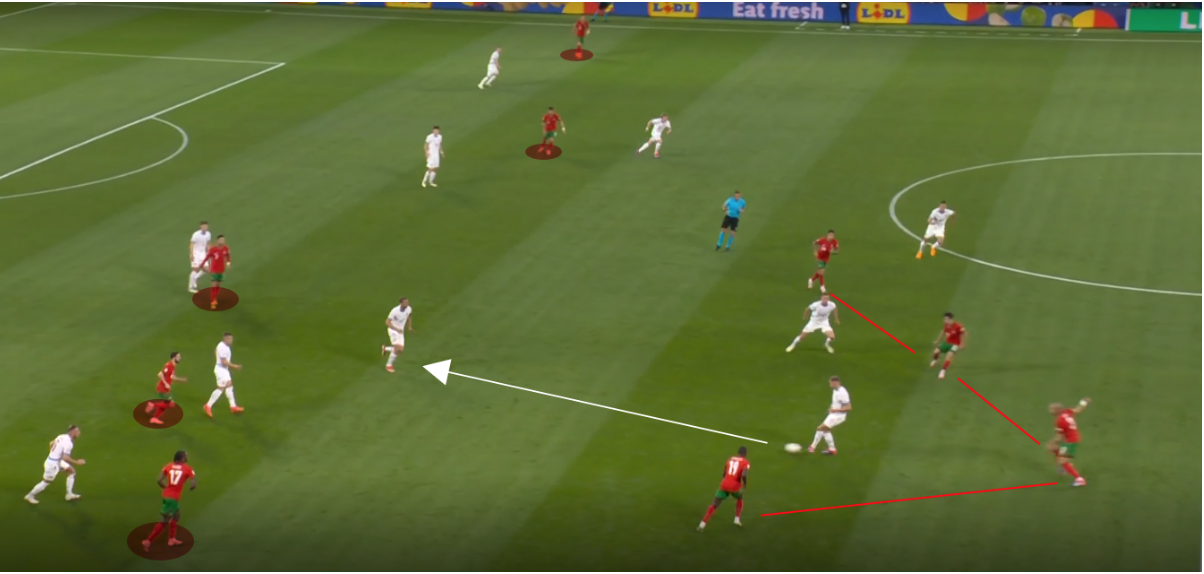
Portugal’s two midfielders—one holding midfielder and one continuous pivot—have been deployed in equal numbers in both the attacking and defensive lines. They have focused on effective build-up and taking advantage of openings and gaps.
The major risk associated with this attacking approach is that a single mistake or lost possession in the midfield by the Portuguese players could result in a goal being conceded, as the defenders are outnumbered giving opponents more time and space. Portugal attempted to erase this deficit quickly, which they eventually achieved, but quick transitions may cause chaos for the men in red when playing against a team with a lot of pace.
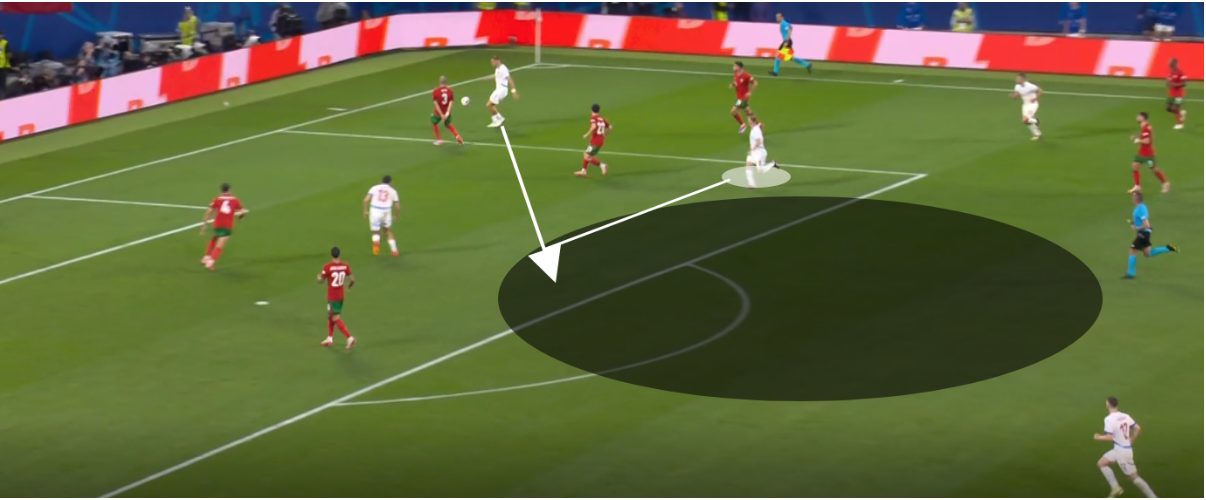
The team’s offensive playbook prevents them from putting additional players in the midfield, which contributes to their defensive woes. Due to Portugal’s inability to play their style of play, they are forced to retreat behind the defensive line in an effort to stop playmakers from breaking lines.
This creates a space in the midfield, which the Czech players cleverly exploited to put additional pressure on Portugal. The players in white were able to have a focused moment during which they nearly scored a goal throughout the game thanks to this tactic.
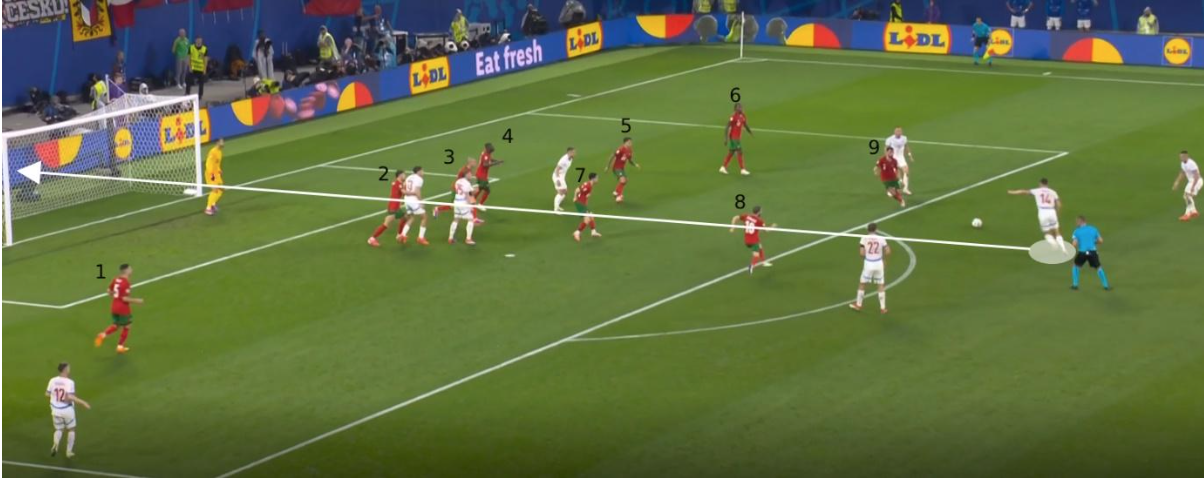
When the men in white broke the deadlock in the 62nd minute due to a similar circumstance, Portugal’s inability to cover and dominate the midfield nearly won the match for Czechia. Portugal was outplayed in midfield when they switched from offensive to defence after losing the ball, forcing its players to drop back and support the defensive line, which gave Czechia more room to maneuver in the midfield.
Ten out of the eleven players in the field are in the box, creating an excessive amount of space in and around the 18-yard box. As a result, no Portuguese player was able to close down the opponent’s midfielder when the ball was passed to them because the move went against their momentum.
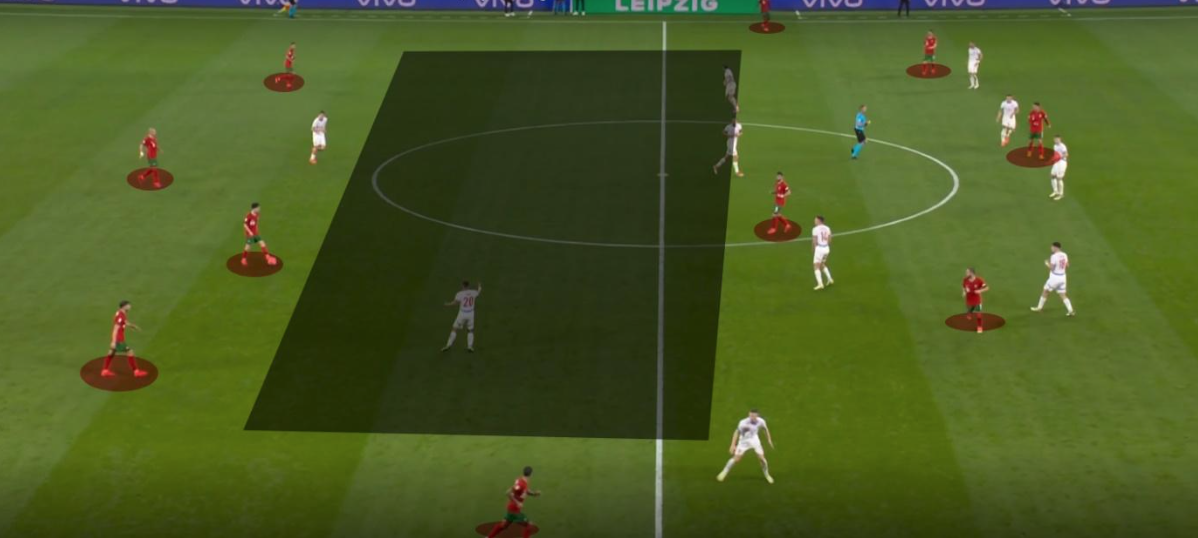
After conceding Portugal switched back to their usual setup of leaving a pocket of space inviting pressure from the opposition to release the players by passing and releasing balls, this was the type of play Portugal used in the qualifying and practice games.
Here, the gap between the defensive line and attacking line will eliminate a minimum of 3 players from the opposition when they try to press. This creates an opening which will be exploited by the holding midfielder to shift the play from mid-3rd to att-3rd.
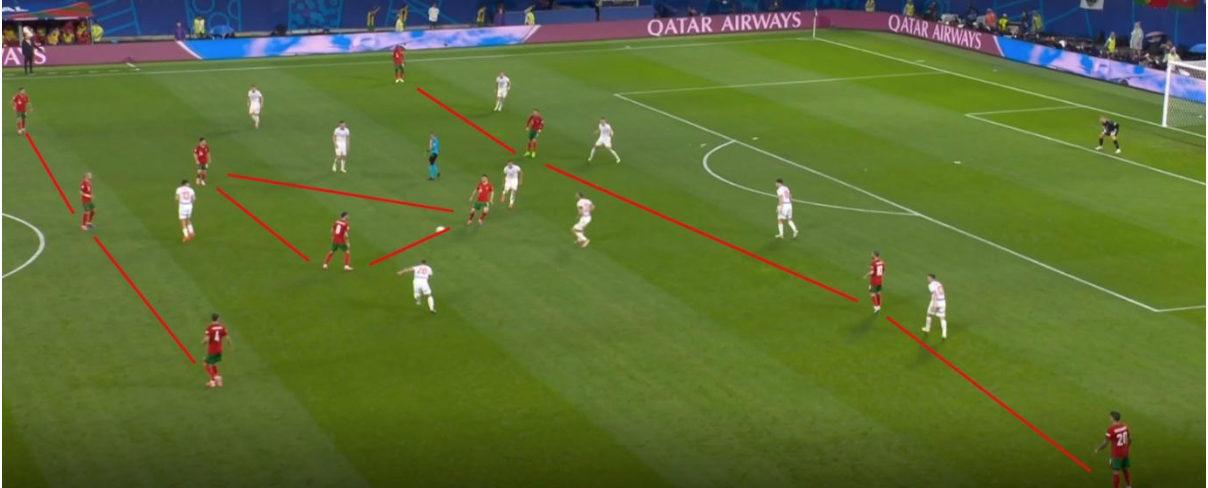
Roberto Martinez changed to a 3-3-4 formation from a 4-2-4; one in the middle of the third quarter. Forming a strong force between the centre back and the back three, the two defensive midfielders keep up a position that covers that gap. Portugal was able to exert more pressure thanks to this kind of defensive line, since they were able to win the ball back by counter-pressing with greater numbers in the midfield.
Portugal’s key tactic in scoring 31 goals in the qualification rounds was to switch the play to the other side of the pitch and cross in, which is why the attacking midfielder in the above picture will act as a high-line pivot supporting the two strikers and two holding midfielders.
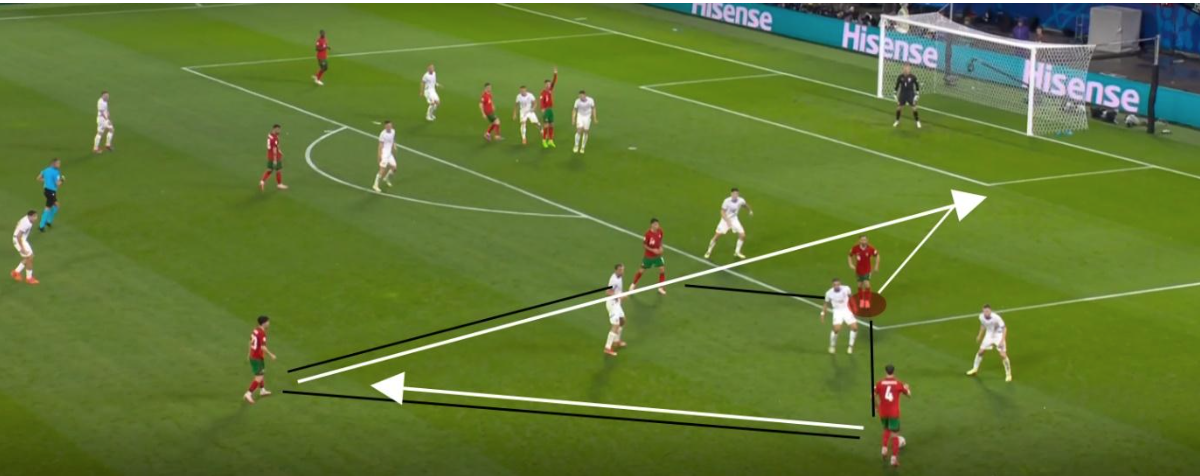
It is harder for the opposition to monitor and mark players when a player operates as the pivot between the striker and the holding midfielders, providing an extra man in the attacking line for crosses. Here, the Portuguese players adopt their customary four-man formation and deploy an additional man in the box to help Vitinha locate Bernardo Silva, who is able to enter the box after receiving a pass from Ruben Dias.
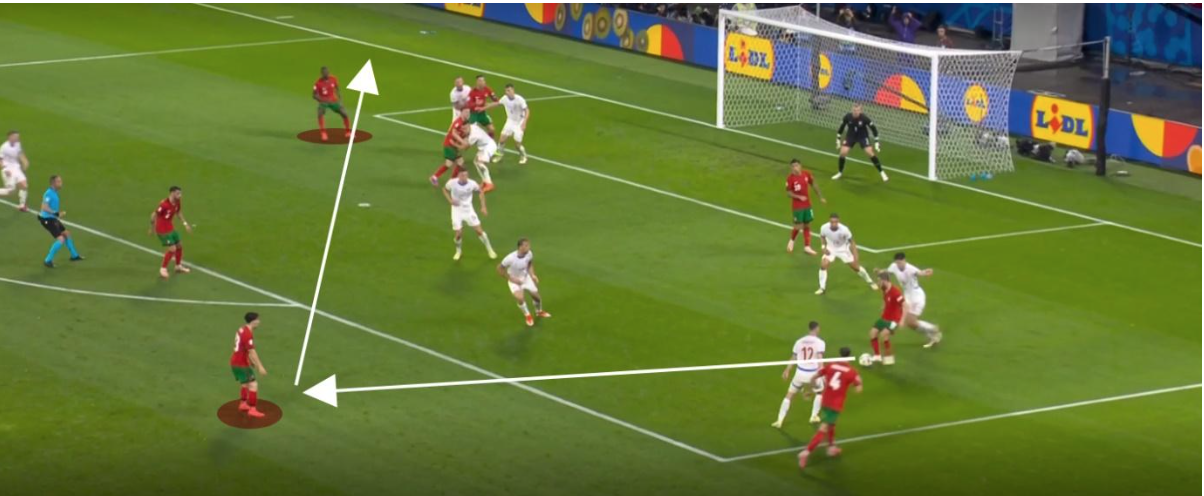
In order to compel the opposition players to score an own goal to tie the score in the 69th minute, Silva immediately cuts the pass back to Vitinha as he crosses it for Nuno Mendes’ first goal at the far post. Their ability to find the back of the net aerially is their strongest play, even with their fast tempo and distinctive finishing and technique.
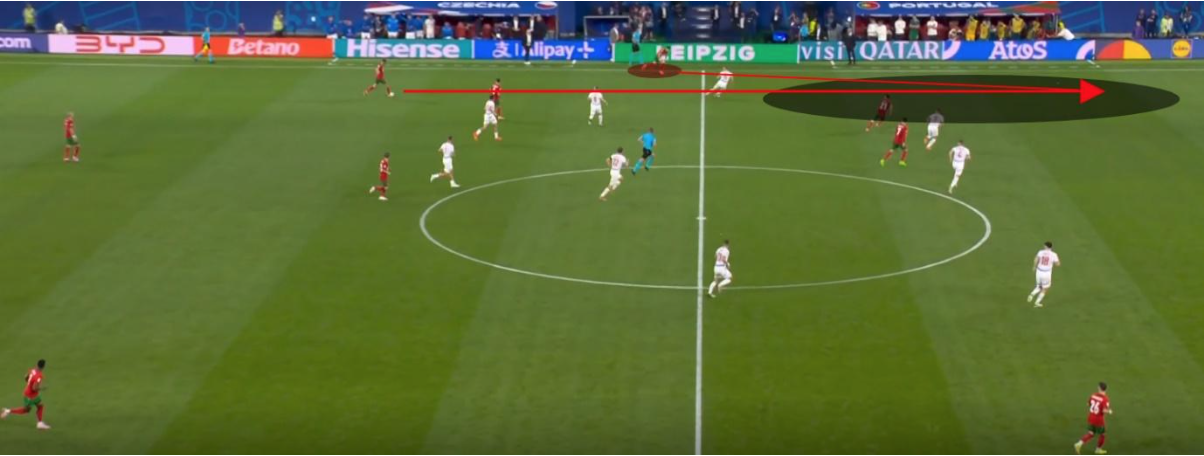
Arguably the last move of the game was a pure counter-attack when the ball was won in the defensive 3rd when Nelson Semedo released Pedro Neto on the left flank giving hope for the Portugal players with one last chance.
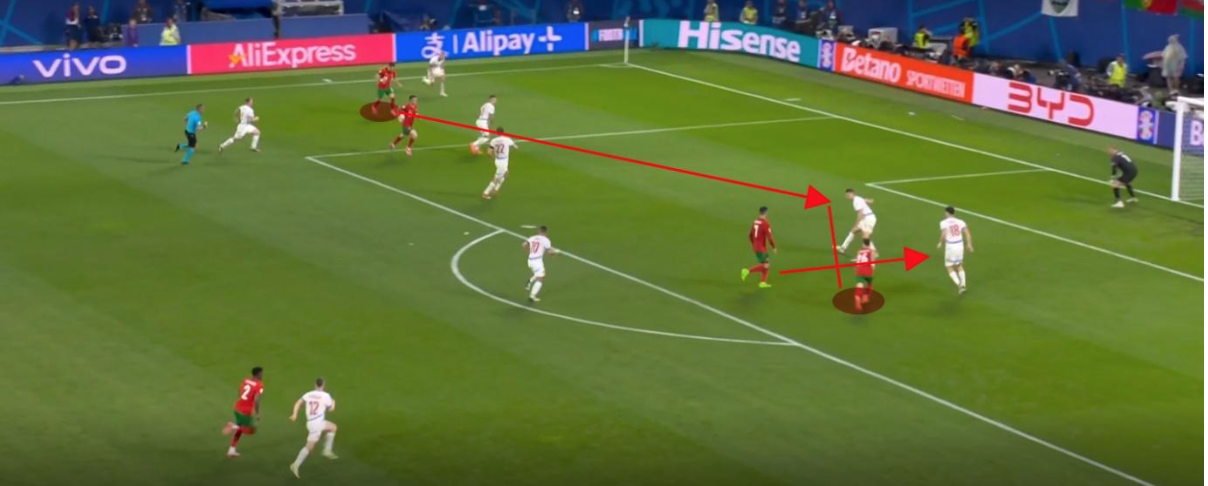
Despite the fact that the play began as a counterattack, Portugal’s execution of the move to end the game in the 92nd minute was obviously practiced on the training field. The two strikers in the box make inverted runs as Neto enters the box, confusing and distracting their markers. This led to a small error by the Czech defence, on which Francisco Conceicao quickly capitalized to take the lead and win it for Portugal.
Roberto Martinez has instilled the philosophy of perseverance and playing dominant football till the very end in this Portugal side, which is emerging as the “Golden Generation.” Portugal has been waiting a long time for this; their transition from a low block defensive club to a powerful possession-based squad has been remarkable. Despite the fact that the opening game victory over Czechia came in the very end, there are many positive lessons to be learned from this match.
Portugal enjoyed a run of minutes where they had numerous chances to take the lead, but their greatest strength—accuracy in finishing passes into the penalty box—was lacking. Even though it was a challenging day at work, we succeeded in the end. On June 22, Portugal will play high-flying Türkiye with the hopes of winning and securing a spot in the knockout stages.
By: Sive Vishwa / @Sive_Vishwa
Featured Image: @GabFoligno / Rob Newell – CameraSport
